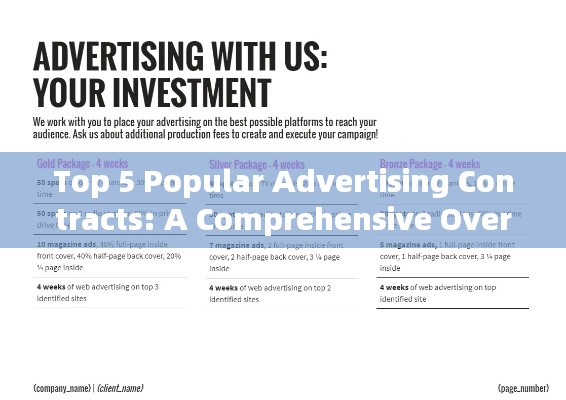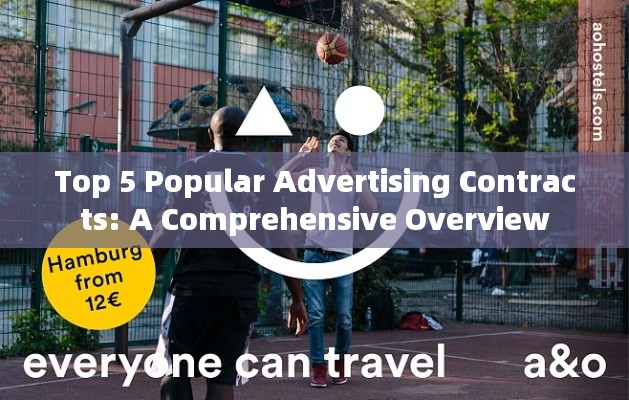标题:Top 5 Popular Advertising Contracts: A Comprehensive Overview
Introduction: Advertising contracts play a crucial role in the world of marketing and business. They provide a legal framework that outlines the terms and conditions between advertisers and advertising agencies. In this article, we will discuss five popular advertising contracts that are widely used in the industry. By understanding these contracts, advertisers and agencies can ensure a smooth and successful partnership.
- Standard Advertising Agreement The Standard Advertising Agreement is a widely used contract that establishes the relationship between an advertiser and an advertising agency. It covers various aspects, including the scope of work, payment terms, deadlines, and intellectual property rights. This contract is beneficial for both parties as it provides a clear understanding of their responsibilities and expectations.
Key Points:
- Scope of work: Defines the services to be provided by the advertising agency, such as creative development, media planning, and campaign execution.
- Payment terms: Specifies the payment schedule, fees, and any additional costs involved.
- Deadlines: Sets the timeline for completing the advertising campaign, including the delivery of creative materials and media placements.
- Intellectual property rights: Determines the ownership and usage rights of the advertising materials produced during the campaign.
- Media Placement Agreement The Media Placement Agreement is a contract between an advertising agency and a media outlet. It outlines the terms and conditions for placing advertisements in various media channels, such as television, radio, print, and online platforms. This agreement ensures that both parties are aware of the media placements, rates, and delivery schedules.
Key Points:
- Media placements: Specifies the media channels, publication dates, and ad sizes for the campaign.
- Rates: Includes the cost of advertising space and any applicable discounts or commissions.
- Delivery schedules: Defines the deadlines for delivering the advertisements to the media outlets.
- Cancellation and termination: Provides guidelines for canceling or terminating the agreement if necessary.
- Sponsorship Agreement A Sponsorship Agreement is a contract between a sponsor and an advertiser. It establishes the terms and conditions for a sponsorship arrangement, where the sponsor provides financial or in-kind support to the advertiser in exchange for brand exposure. This agreement is commonly used in sports, entertainment, and corporate events.
Key Points:
- Sponsorship scope: Defines the activities, events, or programs that the sponsor will support.
- Brand exposure: Outlines the ways in which the sponsor's brand will be promoted, such as logo placement, signage, and mentions.
- Payment terms: Specifies the sponsorship fees, payment schedule, and any additional costs involved.
- Duration and termination: Determines the duration of the sponsorship and the conditions for terminating the agreement.
- Digital Advertising Agreement With the increasing popularity of digital advertising, the Digital Advertising Agreement has become a crucial contract. It governs the relationship between an advertiser and a digital advertising platform or agency. This agreement covers aspects such as ad placement, targeting, performance metrics, and payment terms.
Key Points:
- Ad placement: Specifies the websites, apps, or platforms where the advertisements will be displayed.
- Targeting: Defines the criteria for selecting the target audience, such as demographics, interests, and behaviors.
- Performance metrics: Outlines the key performance indicators (KPIs) to measure the success of the campaign, such as clicks, impressions, and conversions.
- Payment terms: Specifies the payment structure, fees, and any performance-based compensation.
- Co-Branding Agreement A Co-Branding Agreement is a contract between two or more companies that want to collaborate on a marketing campaign. It establishes the terms and conditions for sharing brand elements, such as logos, colors, and messaging. This agreement is commonly used in joint ventures, partnerships, and promotional activities.
Key Points:
- Brand elements: Defines the specific brand elements that will be used in the co-branded campaign.
- Usage rights: Specifies the rights and limitations of using each party's brand elements.
- Marketing activities: Outlines the marketing activities and promotional materials that will be created and distributed.
- Payment and compensation: Determines the financial arrangements and compensation for each party involved.
Conclusion: Understanding the various types of advertising contracts is essential for advertisers and advertising agencies to ensure a successful partnership. The five popular advertising contracts discussed in this article provide a comprehensive overview of the terms and conditions that govern these relationships. By familiarizing themselves with these contracts, advertisers and agencies can navigate the complexities of the advertising industry with confidence.
"Advancements in Multiplex Real-Time PCR: A Comprehensive Overview"
Title: Mastering the Art of Crafting Popular Copy: A Comprehensive Guide in English
Unveiling the Magic of Hot Products: A Comprehensive Guide
Trending Topics: Decoding the English Language of Popularity Charts
Trending Topics in English: Exploring the Hottest Subjects of the Moment
Real-Time Curve Analysis: A Comprehensive Guide
Title: "The Rising Popularity of Man Tou: Exploring the Hot Topics in Chinese Bread"
















 闽ICP备2021015086号-1
闽ICP备2021015086号-1